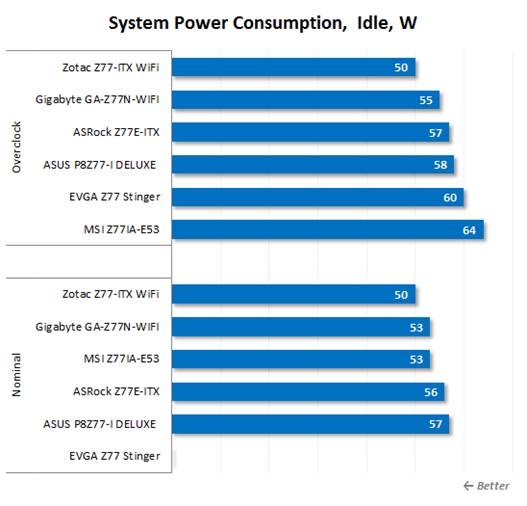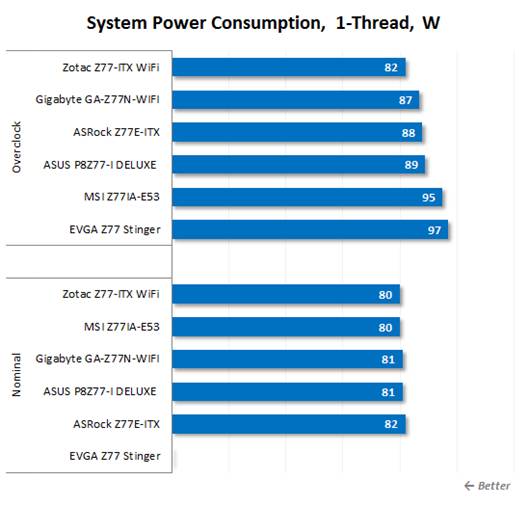Power consumption
Power consumption is a critical factor for
a Mini-ITX mainboard because it directly affects how quiet and economical the
compact computer will be. A small difference in power consumption can be
important for compact PC because it may require an additional fan or a
higher-wattage PSU. Mainboard makers can have a serious effect on the power
draw of the assembled PC by designing an efficient CPU voltage regulator.
Therefore, we performed an experiment to
test the power consumption of the Mini-ITX mainboards based on the Z77 using
our Corsair AX760i PSU with its monitoring capabilities. The diagram below
shows the maximum consumption of each system (without the screen) is measured
at the output of the PSU. It is the sum total of the power draw of each system
component. The efficiency of the PSU is not included.
The CPU was running 64-bit version of the
Linx 0.6.4. utility. We enable C1E, C6, Enhanced Intel SpeedStep and Turbo
Boost to accurately measure power consumption of the system in idle mode and at
low load. As in the performance testing, we test the system at default
settings and overclocked ones.

The
Zotac Z77-ITX WiFi is highly economical when idle
The Zotac Z77-ITX WiFi is highly economical
when idle. The other mainboard needs more energy, especially the Asus P8Z77-I
DELUXE and ASRock Z77E-ITX. The MSI Z77IA-E53 and EVGA Z77 Stinger disable
power saving technology of the CPU and thus requires much more power when
overclocked.

The
single-threaded load evens out the results
The single-threaded load evens out the
results, yet the Zotac Z77-ITX WiFi is still superior in terms of energy
efficiency. The SI Z77IA-E53 is the only mainboard which is able to achieve the
leading position in the default setting.

At
the maximum CPU loads, the Zotac Z77-ITX WiFi losing its leading position
At the maximum CPU loads, the Zotac Z77-ITX
WiFi loses its leading position. The Asus P8Z77-I DELUXE becomes the most
economical CPU with default settings, even though the Zotac is quite
economical, too. The overclocked Zotac-based system consumes less power than
the Gigabyte-based one which has a lower CPU clock rate. By the way, we want to
remind you that the EVGA Z77 Stinger is not in the diagram because that
mainboard drops the CPU clock rate to the default level at full load.
Conclusion
It is very reward to find out that we were
right to assume that the Mini-ITX platform can easily replace a
fully-functional personal computer in standard ATX form-factor.
Our test session showed that the
contemporary LGA 1155 Mini-ITX mainboard has everything an enthusiast needs.
Therefore, they may be used for high-performance machines with discrete gaming
graphics accelerators and may even be overclocked. The only real limitation of
the Mini-ITX platform may be its inability to support multi-card graphics
configurations as well as the lack of unique and rare onboard controller, but
that demand does not always appear. In general, compact systems have every
opportunity to compete with their full-size counterparts.
However, we should also point out that the
market for miniature mainboards for enthusiasts is still somewhat raw. As we
have discovered, there are not many existing options for high-performance
systems. Also, even mainboards based on the best compact Z77 still have
problems. When assembling a full-size computer we have several different mainboard
selections without noticeable drawbacks and with very good potential. However,
it can be quite challenging with the Mini-ITX platform. Officially speaking, a
few mainboards on Z77 are evaluated in this review seem to be a great choice, b
but once we get to know them a little better from a practical standpoint, we
uncover some concerns with settings and configurations, layout, performance or
overclocking. To date, there is no ideal product out there, so we can only hope
that after after Haswell and eight series chipsets launch, the situation would
turn better.
So what should we do if we really want to
build a high-performance LGA 1155 computer on a Mini-ITX platform today? Our
recommendations will start from the opposite side. First, you need to exclude
those mainboards that limit the overclocking. These are Gigabyte GA-Z77N-WIFI,
that doesn’t have any functionality to adjust the voltages, and EVGA Z77
Stinger, that does not work with memory and has several problems in the BIOS.
Then we need to eliminate those mainboards, which cannot save power when the
CPU is idle and disable all processor power-saving technologies during
overclocking. This will take MSI Z77IA-E53 off from the list. Finally, we will
exclude slower mainboards, which means the end of the race for the Zotac
Z77-ITX WiFi.
As a result, two options remaining are Asus
P8Z77-I DELUXE and ASRock Z77E-ITX. Asus's product boasts very thorough design,
high performance and a WiFi controller supporting 5 GHz frequency range.
However, it suffers from a few frustrating problems in the BIOS, high
temperatures and is relatively expensive. The ASRock mainboard, on the
contrary, has very reasonable prices, comes with a well-balanced BIOS and an
additional mSATA slot, but doesn’t support Bluetooth and has somewhat awkward
layout.
After considering all the advantages and
disadvantages, we will have to give our vote to ASUS P8Z77-I DELUXE, which will
be awarded our “Recommended Buy” title. Especially because of the locking of
the processor clock frequency multiplier will most likely be fixed in the
upcoming BIOS updates.
But it's important to remember that the
other discussed products in this review may be a better choice in certain
specific situations. For example, if you do not plan to overclock your system,
then the Gigabyte GA-Z77N-WIFI or MSI Z77IA-E53 will be great options to
consider. Gigabyte board is unique due to two network controllers, while MSI mainboard
provides a free mini-PCIe/mSATA combination slot. However, if you do not
overclock, then you should take look at the Mini-ITX mainboards on H, B and Q
series chipsets, which will cost less and can also give you the desired
function.